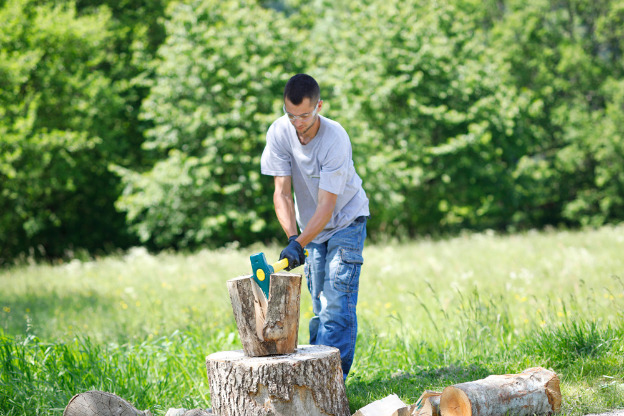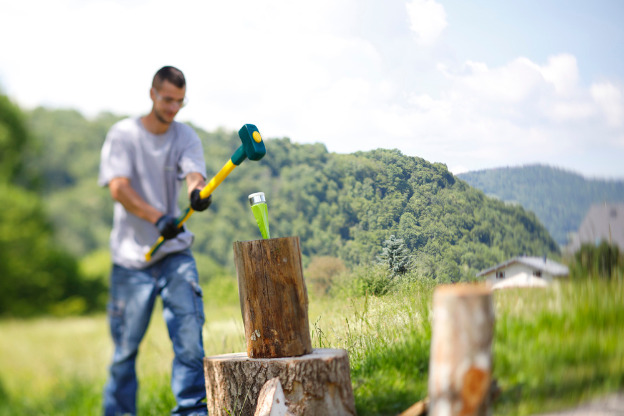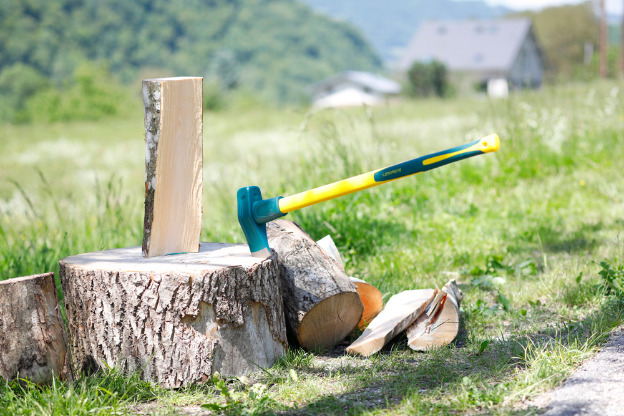Cut and split firewood
Over the last few years we have seen unprecedented enthusiasm for using wood as a means of heating. Although new products such as pallets or wood chips have appeared, the most common fuel is still logs for burning. Splitting mauls and splitting wedges, and also the log-splitter will be invaluable assistants when splitting your logs.
Better combustion of logs split into quarters
The advantage of splitting logs into quarters – the log will burn from its heart and not from the bark- is that the logs catch fire more easily, the fire gives out more calories and there is considerably less soot in your chimney shaft.
Splitting wood which is already calibrated
In most cases your wood is delivered already cut to the right length (30 or 50cm depending on your stove or fireplace) and split. However, it is not unusual to have to split some logs again if you need quartered logs. In this case the ideal tool is the 2.5 kg splitting maul (also called splitting axe) used on a stump of hard wood such as oak or beech.
In some areas woodcutters prefer to cut lengths of 100cm in the forest and then split logs along the whole length before loading them onto the trailer. To split these logs again it is necessary to use the 3.7 kg maul and very often a splitting wedge for the first strike.

Splitting logs easily and safely
By using the splitting maul (with its metal striking surface) together with the Securi-T wedge (with its polymer striking surface) or the Securi-T splitting maul (3kg) and a wedge made of metal. The polymer striking surface of the wedge or of the splitting maul does not require grinding after metal edging which may result in metal splinters which could injure the user. To gain more efficiency and safety it is counterproductive to use the Securi-T splitting maul with an Securi-T wedge.
Log-splitter : lighter and more precise
Log-splitter : lighter and more precise
Composed of a tube which slides inside a second steel tube with a wedge at the end, the log-splitter allows you to work without having to lift the maul above your head. Twisting the back is avoided and very little effort is required because only the upper part of the log-splitter needs to be lifted. Ideal in places with a low ceiling. Another advantage is, as the wedge is placed directly on the log, the tool is very precise. It is no longer necessary to aim at the log which eliminates all risk of mis-hits. The only requirement is to use logs of standard dimensions.
Tip : to cut kindling, place the loges vertically in a tyre until all the space is full and use the log-splitter to cut small sections. This will mean that you do not need to use a hatchet and guarantees greater safety when making this gesture.

Splitting logs in all shapes
If you gather wood in all shapes and do all your own wood-cutting, with an axe for small diameters, you will need several appropriate tools :
Use the 2.5kg splitting maul to split the small diameter logs again (less than 30cm).
For the stump, large diameter logs and logs with branch knots, you should use the 3.7kg splitting maul
In the most difficult cases, you must use a splitting wedge and strike it with the 2.5kg or the 3.7kg splitting maul, or even a 3 to 4kg sledgehammer.
Beware of bad good practices
For wood which is very easy to split, it is not unusual to use an axe. We would not advise this however, because the axe often sticks in the wood without splitting it and then it is difficult and dangerous to remove it.
Some people also use a cutting sledgehammer to split wood: the advantage is that it can weigh 5kg, but let’s leave this tool to those strong enough to use such a heavy weight.

Novagrip fibreglass handle : an investment bringing rapid returns !
The first Novagrip fibreglass handle was created by Leborgne specifically for wood splitting tools.
In fact splitting wood has always consumed a large number of spare handles, as mis-hits are frequent.
For your comfort and your safety the Novagrip fibreglass handle is practically obligatory from the start. The extra cost very often pays for itself in just one working day…

